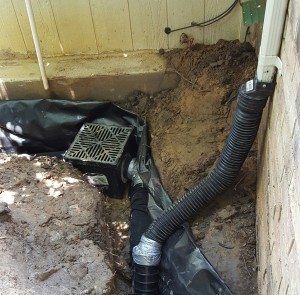Commercial and residential properties with recurring rainwater issues require a well-functioning drainage system. Proper drainage prevents water from accumulating near critical structures of your home. Without these systems, water pooling can gradually damage the foundation, walls, and basements.
However, different drain types resolve various moisture and water damage issues. This leads people to ask which is better, surface drain vs. French drain. Certified contractors from HD Foundations can help you choose the right drain system best suited for your home. We thoroughly inspect your property and design custom drainage systems to suit your needs.
The Value of Expert Insights in Drainage Systems
To determine what kind of foundation drainage system you should install, have a foundation expert evaluate your property. While surface drains can be of great benefit to many homeowners, you may want to pick French drains as opposed to surface drains if massive amounts of moisture around your foundation are not an issue. Of course, flooding that occurs suddenly due to 4-5” of rainfall or more in the North Texas area can cause standing water. To avoid foundation trouble, it’s important to make sure that precipitation or other forms of moisture are directed away from your house.
When selecting a drainage system for your foundation, contact a local foundation repair contractor. It’s important to learn the pros and cons of each system. To get more general information, read three tips for avoiding foundation drainage problems. Rainfall levels can go above normal in the DFW area due to unusual weather patterns, so you may want to have your foundation examined soon.
Factors to Consider Before Installation
Each drain system has unique features. When comparing a French drain vs. a surface drain, it is best to consider the conditions on your property contributing to rainwater accumulation. One drainage type may be more suitable for your property than another.
While considering surface drain vs. French drain designs, contractors will inspect your location, soil conditions, and the type of building being worked on. Here are some of the factors to consider when selecting drainage systems:
1. Drainage Needs
Licensed contractors will inspect your building or home to determine the drainage needs. When comparing a surface drain vs. a French drain, you’ll find that each type is suited for different drain conditions:
- Surface Drains: This type of drain is typically used to collect and remove excess rainwater from flat or slightly sloped surfaces. Examples of these include patios, driveways, and sidewalks. They effectively manage surface water runoff, prevent flooding, and protect landscaping.
- French Drain: French drains, on the other hand, are designed to address subsurface water issues. They are better suited for redirecting and managing groundwater, especially in areas with poor soil drainage or where water collects in low spots.
2. Layout
The materials and layout used to build these two drainage systems will differ. One is simpler and easier to install.
- Surface Drains: This type of drain features metal grating and a flexible PVC pipe. Since this system requires fewer components, it is easier to build and takes less time to install. Due to their design, these drain systems can also be installed in concrete areas, like a garage or den, where water accumulates.
- French Drains: This drainage system features a trench, a perforated PVC pipe, permeable wrapping, and a layer of gravel. Due to its design, this type of drainage system is better at preventing soil erosion, making it a good option for gardens and other sections of your yard. It may be more challenging to install, but it lasts a long while with proper maintenance.
3. Purpose and Functional Area
When comparing a French drain vs. a surface drain, you’ll notice differences in their function and areas where they are installed.
- Surface Drain: This drainage system is designed for collecting large volumes of water quickly, which is beneficial for areas that tend to get flooded quickly. These drains can be placed around four feet from a foundation, rapidly collecting water after heavy rainfall and preventing stress on your home’s structures.
- French Drain: This drainage system can be placed near the foundation and other areas on your property, such as gardens and landscaped yards. If the soil on your property is prone to oversaturation, a French drain can efficiently channel any amount of trapped water underground.
4. Cost
When comparing a surface drain vs. a French drain, consider the project’s cost.
- Surface Drains: Surface drains are generally more affordable to install than French drains, requiring less excavation and material.
- French Drains: French drains, on the other hand, can be more expensive due to the labor-intensive excavation process and the cost of gravel, pipes, and other materials.
When to Choose a French Drain Foundation Drainage System vs. Surface Drain
If you live anywhere in the DFW area, it’s wise to select this type of system when your house foundation has moisture slowly seeping beneath it. Address drainage issues before standing water is all around it. When choosing a French drain or surface drain, it’s important to remember that a French drain is designed to collect water that is accumulating below the surface, not above it. This is directly opposed to a surface drain, which collects moisture at the surface of the earth. You may want to study information on the drainage installation process for French drains and surface drains.
Creating these particular types of systems involves digging a trench around your foundation. A non-porous plastic liner is generally placed in the bottom of the channel and draped up against the foundation in order to serve as a moisture barrier. Water drains through a perforated pipe that is placed inside the trench and covered with approximately ½” of rock or crushed pebble. A French drain is a good drainage system to pick if your foundation is exposed to average amounts of rainfall and is not threatened by serious flooding conditions.
When is a Surface Drain the Best Choice?
It’s wise to install a system of this type when water is collecting right up against your concrete slab or underneath your pier and beam foundation. Pooling or ponding of water is cause for concern, especially in the metroplex. If you have a negatively sloped yard (which slopes toward your foundation), a surface drainage system is a better choice than a French drain. Sloping of more than 1”-1-1/2” on a 10’ run can result in excessive amounts of water seeping beneath your house. If the soil around your foundation always seems to be damp, the high moisture content in the dirt indicates that water is creeping under the soil and could be affecting your house. You might want to read about drainage systems or foundation repair. This is because foundation upheaval can become an issue if this situation is not resolved by a contractor.
Picking One Drainage System as Opposed to The Other
When deciding whether you should select a French drain vs. a surface drain, consider this: The difference between the two is that a French drain is that a surface drainage system consists of collection boxes that are installed for the specific purpose of removing water that is located on the surface of the ground. If you have ponding or flooding issues, this is the type of drain you need. These boxes are connected to discharge pipes that can direct water as far away from your foundation as necessary. They can be 4’ long or well over 40’ long, depending upon whether the water is being discharged towards the street or to the outer edges of your property. An expert who does foundation work can tell you if you are all about open-top as well as closed-top surface drainage systems. Contact HD Foundations to schedule a free evaluation. We service the entire DFW area.
 REQUEST A FREE ESTIMATE
REQUEST A FREE ESTIMATE





